Papers by Jane Schneiderman
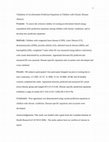
Pediatric exercise science, 2015
To assess the criterion validity of existing accelerometer-based energy expenditure (EE) predicti... more To assess the criterion validity of existing accelerometer-based energy expenditure (EE) prediction equations among children with chronic conditions, and to develop new prediction equations. Children with congenital heart disease (CHD), cystic fibrosis (CF), dermatomyositis (JDM), juvenile arthritis (JA), inherited muscle disease (IMD), and haemophilia (HE), completed 7 tasks while EE was measured using indirect calorimetry with counts determined by accelerometer. Agreement between EE predicted and measured EE was assessed. Disease-specific equations and cut points were developed and cross-validated. 196 subjects participated. One participant dropped out prior to testing due to time constraints, 15 CHD, 32 CF, 31 JDM, 31 JA, 30 IMD, 28 HE and 29 healthy controls completed the study. Agreement between predicted and measured EE varied across disease group and ranged (ICC) 0.13-0.46. Disease specific prediction equations exhibited a range of results (ICC 0.62 to ICC 0.88) (SE 0.45-0.78...

PLOS ONE, 2015
To study the effects of L-arginine (L-Arg) on total body aerobic capacity and muscle metabolism a... more To study the effects of L-arginine (L-Arg) on total body aerobic capacity and muscle metabolism as assessed by 31Phosphorus Magnetic Resonance Spectroscopy (31P-MRS) in patients with MELAS (Mitochondrial Encephalomyopathy with Lactic Acidosis and Stroke-like episodes) syndrome. We performed a case control study in 3 MELAS siblings (m.3243A>G tRNAleu(UUR) in MTTL1 gene) with different % blood mutant mtDNA to evaluate total body maximal aerobic capacity (VO2peak) using graded cycle ergometry and muscle metabolism using 31P-MRS. We then ran a clinical trial pilot study in MELAS sibs to assess response of these parameters to single dose and a 6-week steady-state trial of oral L-Arginine. At baseline (no L-Arg), MELAS had lower serum Arg (p = 0.001). On 31P-MRS muscle at rest, MELAS subjects had increased phosphocreatine (PCr) (p = 0.05), decreased ATP (p = 0.018), and decreased intracellular Mg2+ (p = 0.0002) when compared to matched controls. With L-arginine therapy, the following trends were noted in MELAS siblings on cycle ergometry: (1) increase in mean % maximum work at anaerobic threshold (AT) (2) increase in % maximum heart rate at AT (3) small increase in VO2peak. On 31P-MRS the following mean trends were noted: (1) A blunted decrease in pH after exercise (less acidosis) (2) increase in Pi/PCr ratio (ADP) suggesting increased work capacity (3) a faster half time of PCr recovery (marker of mitochondrial activity) following 5 minutes of moderate intensity exercise (4) increase in torque. These results suggest an improvement in aerobic capacity and muscle metabolism in MELAS subjects in response to supplementation with L-Arg. Intramyocellular hypomagnesemia is a novel finding that warrants further study. Class III evidence that L-arginine improves aerobic capacity and muscle metabolism in MELAS subjects. ClinicalTrials.gov NCT01603446.
Psychology of Sport and Exercise, 2011
... Qualitative studies have also revealed that parents experience their child's illness as ... more ... Qualitative studies have also revealed that parents experience their child's illness as “life shattering, life altering, and self-obliterating” (Woodgate & Degner, 2003), threatening the very ...Diana's mother expressed stress and sorrow related to her child's treatment non-adherence. ...

Physical & Occupational Therapy in Pediatrics, 2009
Children with arthritis face challenges when they try to increase their physical activity. The st... more Children with arthritis face challenges when they try to increase their physical activity. The study's objective was to identify elements of a successful community-based exercise program for children with arthritis by investigating the perspectives of fitness instructors who led the program. This qualitative study used a phenomenological approach. Four fitness instructors participated in individual interviews. Themes were developed through inductive analytic methods. Three main themes were identified: (a) children with arthritis require encouragement and guidance throughout the program from fitness instructors who understand their arthritis, and support from parents and peers; (b) children need help to overcome their negative perceptions about exercise; and (c) exercise program participation can launch the adoption of a more active lifestyle. Pediatric physiotherapists can encourage the establishment of successful exercise programs for children with arthritis in nonmedical or community environments through the formation of supportive, education-based partnerships with community-based fitness instructors.
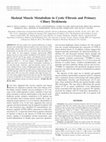
Pediatric Research, 2011
Previous studies have reported differences in muscle function and metabolism between patients wit... more Previous studies have reported differences in muscle function and metabolism between patients with cystic fibrosis (CF) and healthy controls (HC), but it is currently unknown whether these abnormalities are specific to CF or also seen in other airway diseases. In this study, we used magnetic resonance spectroscopy (MRS) during exercise to assess muscle metabolism in CF patients. Twenty patients with CF and 20 age, gender, and habitual activity-matched HCs and a respiratory disease comparison group with primary ciliary dyskinesia (PCD; n ϭ 10) were studied. 31 Phosphorus MRS ( 31 P-MRS) was used to characterize muscle bioenergetic metabolism at rest and after high-, moderate-, and low-intensity exercise. CF patients exhibited lower resting ATP/phosphocreatine (PCr) ratio and significantly higher end-exercise pH values compared with both HC and PCD patients. Both CF and PCD patients demonstrated significantly slower PCr recovery time constants after high-intensity exercise. Our results suggest that not only there are specific abnormalities of muscle metabolism in CF patients but also there is a nonspecific impact of respiratory disease on muscle function. (Pediatr Res 69: 40-45, 2011)
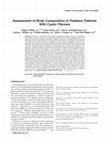
Pediatric Pulmonology, 2008
Rationale: Cystic fibrosis (CF) leads to pathological changes in organs that express the cystic f... more Rationale: Cystic fibrosis (CF) leads to pathological changes in organs that express the cystic fibrosis transmembrane conductance regulator (CFTR), including secretory cells of the digestive tract and the pancreas. Maintaining nutritional sufficiency is challenging for CF patients and therefore accurate monitoring is important for their clinical management. Purpose: The objectives of this study were to evaluate the effectiveness of skinfold measurements as an accurate method for determining body composition (fat mass (FM) and lean body mass (LBM)) of this population, using dual-energy X-ray absorptiometry (DEXA) as a gold standard comparison and to determine the most accurate equation for this calculation in children with CF. Methods: Fifty-five pediatric patients with CF participated in the study. FM and LBM calculated via four methods: Slaughter, Durnin, Durenberg (2-site and 4-site). The relationship between the methods and DEXA results were estimated by intraclass-correlation coefficient (ICC) and Bland and Altman analyses. Results: The Slaughter method was the most accurate (ICC of 0.92 for FM and 0.99 for LBM) and displayed the least bias over the range of FM and LBM in CF patients. In addition, the results of Bland Altman analyses comparing each skinfold method to DEXA, revealed that the results were evenly distributed along the range of values for the Slaughter calculation, whereas the other three methods under and over estimated % fat results at the upper and lower ends of the range respectively. Conclusion: We therefore conclude that the Slaughter method may be used for body composition assessment of pediatric CF patients. This provides clinical teams with a simple, accurate and non-invasive method that can be used to monitor nutritional status in pediatric patients with CF.
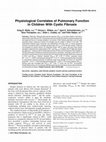
Pediatric Pulmonology, 2013
Rationale: Although peak aerobic capacity (VO 2peak ) has been linked to outcome in patients with... more Rationale: Although peak aerobic capacity (VO 2peak ) has been linked to outcome in patients with cystic fibrosis (CF), measuring is time consuming, and requires expensive equipment and expertise that is not readily available in all centers. Other fitness parameters such as peak anaerobic power, measures of power and strength may be simpler to deliver in the clinic. The relationship between these measures and established outcomes such as forced expiratory volume in one second (FEV 1 ) and peak aerobic power (VO 2peak ) in CF remains unclear. Therefore we evaluated (a) aerobic fitness, (b) anaerobic fitness, and (c) upper and lower body muscle strength to determine their relationship to FEV 1 and VO 2peak in children with CF. Methods: Eightytwo patients (7-18 years) with CF (40 female) from the CF clinic at The Hospital for Sick Children in Toronto performed a maximal incremental cycling test to exhaustion. Anaerobic power (W) for 10 and 30 sec cycling trials as well as vertical jump (VJ) and hand grip strength (HG) were compared to FEV 1 and VO 2peak . Results: Absolute VO 2peak (R 2 ¼ 0.16, P < 0.001), anaerobic power (R 2 ¼ 0.21, P < 0.001), and hand grip strength (R 2 ¼ 0.10, P ¼ 0.003) were significantly correlated to lung function whereas measures of explosive lower body strength (VJ) were not. Anaerobic power (R 2 ¼ 0.16, P ¼ 0.001) and hand grip strength (R 2 ¼ 0.08, P ¼ 0.01) were related to VO 2peak . Vertical jump was correlated with VO 2peak (R 2 ¼ 0.29, P < 0.001) but not FEV 1 . Conclusions: Simple fitness tests such as hand grip strength and anaerobic cycle tests may be useful indicators of lung health and fitness.

Pediatric Pulmonology, 2006
Our objective was to study exercise capacity and cardiorespiratory response to exertion in surviv... more Our objective was to study exercise capacity and cardiorespiratory response to exertion in survivors of congenital diaphragmatic hernia (CDH). This was a cross-sectional cohort study of 23 CDH survivors, aged 10-16 years, and 23 gender- and age-matched controls. Exercise testing was performed on a cycle ergometer, with cardiac output measurements made using exponential CO2 rebreathing. Pretest cardiorespiratory assessment was done by echocardiography and pulmonary function testing. Statistical analysis was performed using Student&amp;amp;amp;amp;amp;amp;#39;s t-test, regression analysis, and longitudinal model computing with spatial covariance structure. No echocardiographic evidence for pulmonary hypertension was found at rest (right ventricular systolic pressures, 27 +/- 6 mmHg). Mean pulmonary artery diameter on the side of the CDH was significantly smaller than contralaterally, but was within normal range (z-score, 0 +/- 1.1 vs. 1.2 +/- 1.6, P &amp;amp;amp;amp;amp;amp;lt; 0.01). Exercise capacity was mildly reduced in CDH compared to controls and predictive data (maximum workload, 77% +/- 12% vs. 91% +/- 16% of predicted, P &amp;amp;amp;amp;amp;amp;lt; 0.01). Cardiorespiratory response to exertion was not significantly different between groups. In conclusion, most adolescent CDH survivors have nearly normal exercise capacity and cardiorespiratory response to exertion. This study may prove useful in comparisons with future cohorts comprising more severely affected individuals now surviving due to improved neonatal care.

Pediatric Pulmonology, 2003
Maximal voluntary ventilation (MVV) may be determined directly by the sprint method or calculated... more Maximal voluntary ventilation (MVV) may be determined directly by the sprint method or calculated from pulmonary function data, using the functions MVV = forced expired volume in 1 sec (FEV(1)) x 35 or MVV = FEV(1) x 40. The purpose of this paper was to test the validity of the equation over a wide range of lung function in children. Cystic fibrosis (CF), a chronic lung disease where children typically have a wide range of pulmonary function, was chosen as the study requirement. Spirometric data from 332 children with CF who underwent pulmonary function testing between 1987-2000 were stratified according to disease severity, and box-plots comparing the ratio of MVV to FEV(1) for each category were generated. As results indicated that the equation underestimates true MVV proportionally to the degree of airflow limitation, a new function to predict MVV for this population was derived and tested. The new equation was derived using data from patients who were tested on odd-numbered days (group A). The validity of the new equation was then tested on the patients tested on even-numbered days (group B). To test its validity, the results were compared to the &amp;amp;amp;amp;amp;amp;amp;amp;amp;amp;amp;amp;quot;gold standard&amp;amp;amp;amp;amp;amp;amp;amp;amp;amp;amp;amp;quot; sprint values using a Bland and Altman plot. MVV was expressed as a function of FEV(1) and predicted FEV(1): MVV = 27.7(FEV(1)) + 8.8(PredFEV(1)) (R(2) = 0.98, P &amp;amp;amp;amp;amp;amp;amp;amp;amp;amp;amp;amp;lt; 0.05). In this way, the accuracy of the new equation was confirmed. Whenever possible, we recommend MVV be determined by the sprint method in accordance with ATS guidelines. If this is not feasible, we recommend considering the new prediction equation.
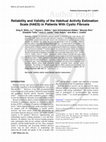
Pediatric Pulmonology, 2008
Purpose To understand potential benefits of exercise in the cystic fibrosis (CF) population, ther... more Purpose To understand potential benefits of exercise in the cystic fibrosis (CF) population, there needs to be accurate methods to quantify it. The Habitual Activity Estimation Scale (HAES) questionnaire has been shown to be a feasible tool to measure physical activity however the reliability and validity has yet to be determined in the CF population. Methods: Fourteen (seven male, seven female) patients aged 16.2 AE 4.2 years with CF participated in this study. Participants were clinically stable at the time of the study and participating in their habitual physical activity. To assess reliability, patients completed the HAES and a validated 3-day activity diary, and wore an ActiGraph TM Accelerometer for two consecutive weeks. Validity was assessed by comparing the activity results of each of the three instruments over a single week time period. Results: ICC estimates of reliability for the HAES, diary, and accelerometer were 0.72 (P < 0.0001), 0.76 (P < 0.0001), 0.63 (P < 0.0001), respectively. Validity analysis indicated that there were significant relationships between the participants' activity results as estimated by the HAES, diary and accelerometer. Further, significant relationships were detected between activity measures when broken into morning, afternoon, or evening periods, and between measures from weekday or weekend days. There were also significant relationships among the three instruments when recording different activity levels (somewhat inactive, somewhat active, and very active). Conclusion: The findings of this study suggest that the HAES questionnaire is a reliable and valid instrument that can be used to assess activities of varying intensity in patients with CF.
Pediatric Blood & Cancer, 2011
Over the past 25 years, the prevalence of overweight in children and adolescents has doubled and ... more Over the past 25 years, the prevalence of overweight in children and adolescents has doubled and obesity has tripled such that childhood overweight is now considered a public health crisis . This population of overweight children and adolescents is at increased risk for morbidity and mortality from chronic health diseases including diabetes, coronary artery disease, and other overweight-related illnesses during adulthood . Overweight has also been associated with an increased risk for the development of cancer during adulthood, and overweight adults with cancer have inferior survival outcomes .
Paediatric Respiratory Reviews, 2009
The Journal of Pediatrics, 2005
Objectives To evaluate the feasibility of measuring habitual physical activity (HPA) in children ... more Objectives To evaluate the feasibility of measuring habitual physical activity (HPA) in children with cystic fibrosis (CF) and to assess the relation between HPA and the rate of decline in FEV 1 over a period of 2 years.
The Journal of Pediatrics, 2000
Cystic fibrosis FEF Forced expiratory flow between 25% and 75% of vital capacity FEV 1 Forced exp... more Cystic fibrosis FEF Forced expiratory flow between 25% and 75% of vital capacity FEV 1 Forced expiratory volume in 1 second FVC Forced vital capacity MVV Maximal voluntary ventilation · VE Minute ventilation · VO 2max Maximal oxygen consumption W max Maximal working capacity
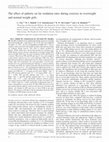
Journal of Applied Physiology, 2014
JK. The effect of puberty on fat oxidation rates during exercise in overweight and normal-weight ... more JK. The effect of puberty on fat oxidation rates during exercise in overweight and normal-weight girls. Excess weight is often associated with insulin resistance (IR) and may disrupt fat oxidation during exercise. This effect is further modified by puberty. While studies have shown that maximal fat oxidation rates (FOR) during exercise decrease with puberty in normal-weight (NW) and overweight (OW) boys, the effect of puberty in NW and OW girls is unclear. Thirty-three NW and OW girls ages 8 -18 yr old completed a peak aerobic capacity test on a cycle ergometer. FOR were calculated during progressive submaximal exercise. Body composition and Tanner stage were determined. For each participant, a best-fit polynomial curve was constructed using fat oxidation vs. exercise intensity to estimate max FOR. In a subset of the girls, IR derived from an oral glucose tolerance test (n ϭ 20), and leptin and adiponectin levels (n ϭ 11) were assessed in relation to FOR. NW pre-early pubertal girls had higher max FOR [6.9 Ϯ 1.4 mg·kg fat free mass (FFM) Ϫ1 ·min Ϫ1 ] than NW mid-late pubertal girls (2.2 Ϯ 0.9 mg·kg FFM Ϫ1 ·min Ϫ1 ) (P ϭ 0.002), OW pre-early pubertal girls (3.8 Ϯ 2.1 mg·kg FFM Ϫ1 ·min Ϫ1 ), and OW mid-late pubertal girls (3.3 Ϯ 0.9 mg·kg FFM Ϫ1 ·min Ϫ1 ) (P Ͻ 0.05). Bivariable analyses showed positive associations between FOR with homeostatic model assessment of IR (P ϭ 0.001), leptin (P Ͻ 0.001), and leptin-to-adiponectin ratio (P ϭ 0.001), independent of percent body fat. Max FOR decreased in NW girls during mid-late puberty; however, this decrease associated with puberty was blunted in OW girls due to lower FOR in pre-early puberty. The presence of IR due to obesity potentially masks the effect of puberty on FOR during exercise in girls.
European Journal of Clinical Nutrition, 2011
The purpose of this study was to develop an activity energy expenditure (AEE) prediction equation... more The purpose of this study was to develop an activity energy expenditure (AEE) prediction equation for the Actiheart activity monitor (AH) for use in children with chronic disease.
European Journal of Applied Physiology, 2010
Exercise is beneficial for patients with cystic fibrosis (CF) but long-term effects of physical a... more Exercise is beneficial for patients with cystic fibrosis (CF) but long-term effects of physical activity on lung function evolution are unknown. We evaluated the longitudinal relationship between changes in habitual physical activity (HPA) and rate of decline in lung function in patients with CF.
Canadian Journal of Diabetes, 2013
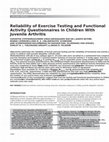
Arthritis & Rheumatism, 2007
To determine the reliability of formal exercise testing and the reliability of functional and act... more To determine the reliability of formal exercise testing and the reliability of functional and activity questionnaires in children with juvenile idiopathic arthritis (JIA). Children with JIA of any subtype ages 8-16 years who were recruited to a randomized trial comparing different exercise therapies participated in 2 preintervention sessions of exercise testing 2-6 weeks apart. Exercise testing included 1) submaximal oxygen uptake (VO(2submax)), 2) peak VO(2) (VO(2peak)), and 3) anaerobic power using modified Wingate tests (W(ant)). Two physical function questionnaires (the Childhood Health Assessment Questionnaire [C-HAQ] and Revised Activity Scale for Kids [ASK]) and 1 daily physical activity questionnaire (the Habitual Activity Estimation Scale [HAES]) were also completed at these times. Test-retest reliability was assessed using type 3, intrarater intraclass correlation coefficient (ICC(3,1)) and Bland and Altman plots were used to determine limits of agreement. Data were available for 74 patients (58 girls). VO(2submax), VO(2peak), and W(ant) demonstrated high reliability (ICC(3,1) 0.82, 0.91, and 0.94, respectively). C-HAQ and ASK questionnaires also had very high reliability (ICC(3,1) 0.82 and 0.91, respectively). The HAES demonstrated low reliability for total activity score (ICC(3,1) 0.15) and moderate reliability when the number of very active hours was analyzed separately (ICC(3,1) 0.59). Results of this investigation suggest that exercise testing and functional questionnaires in children with JIA are consistent and reliable. Reliability of the HAES total score was poor, but moderate when the very active hours subscale score was used.
Arthritis & Rheumatism, 2007




Uploads
Papers by Jane Schneiderman